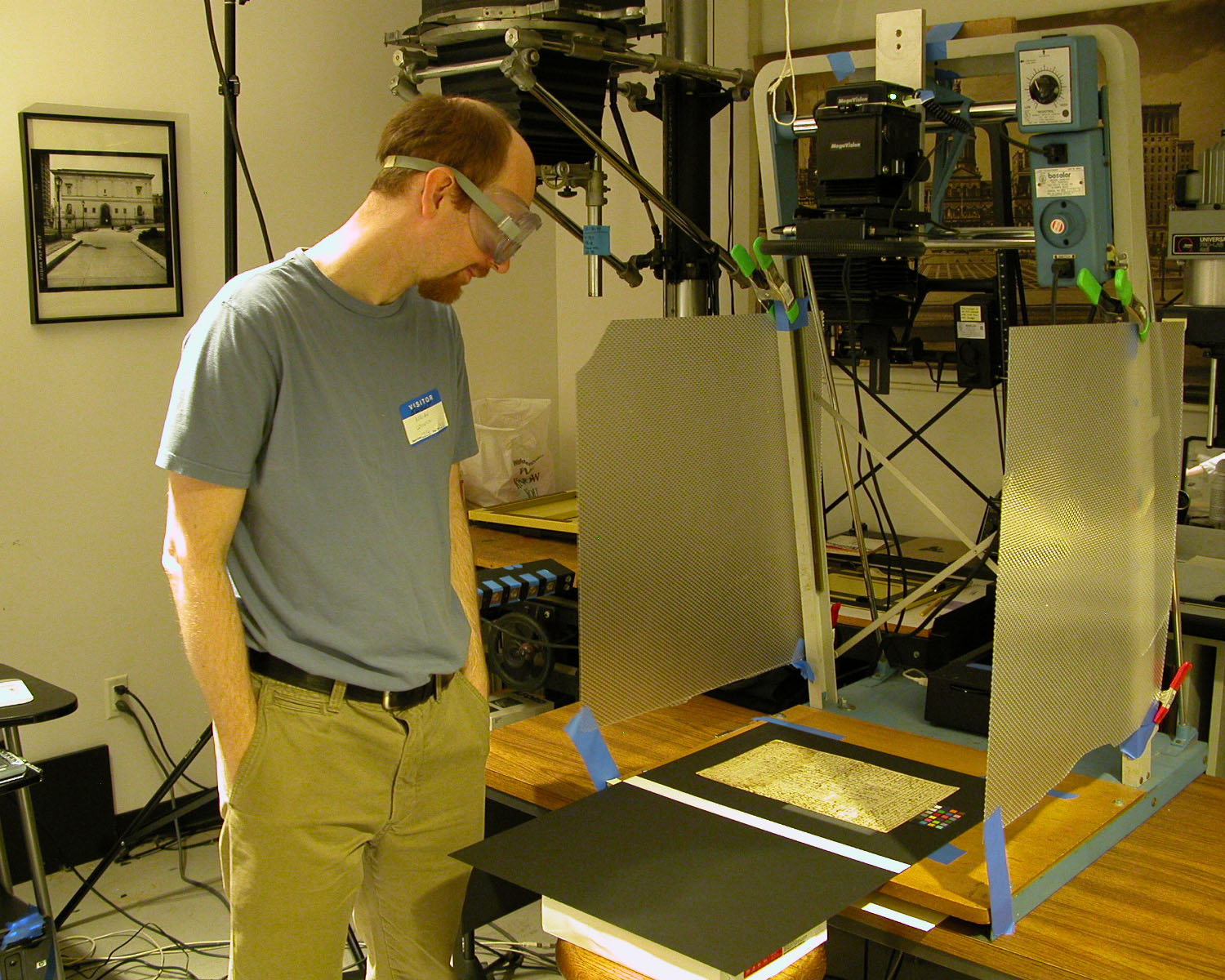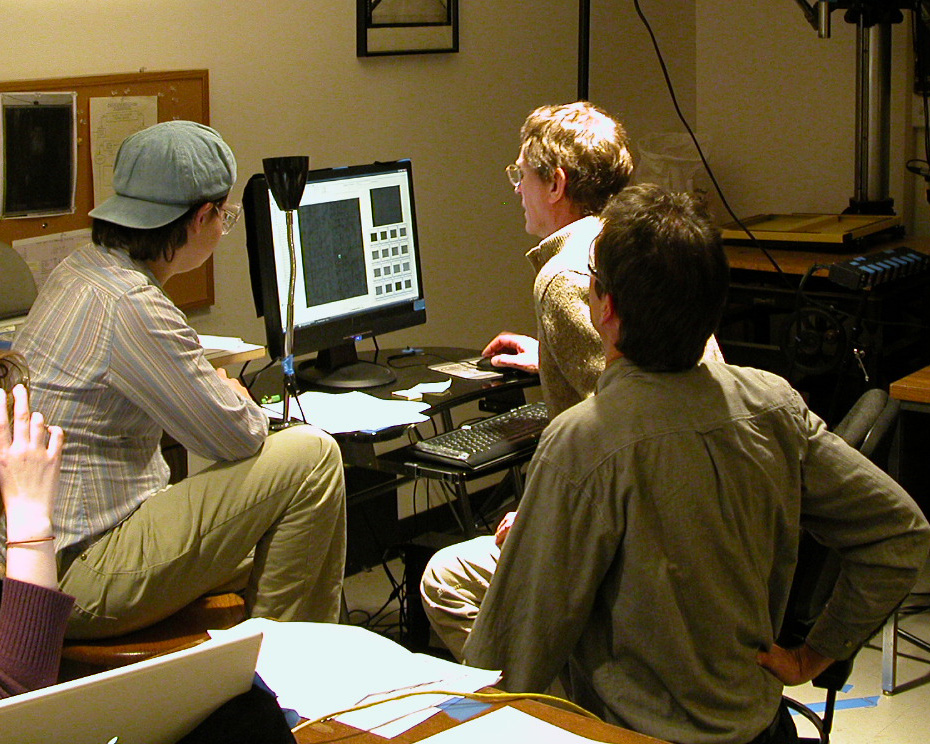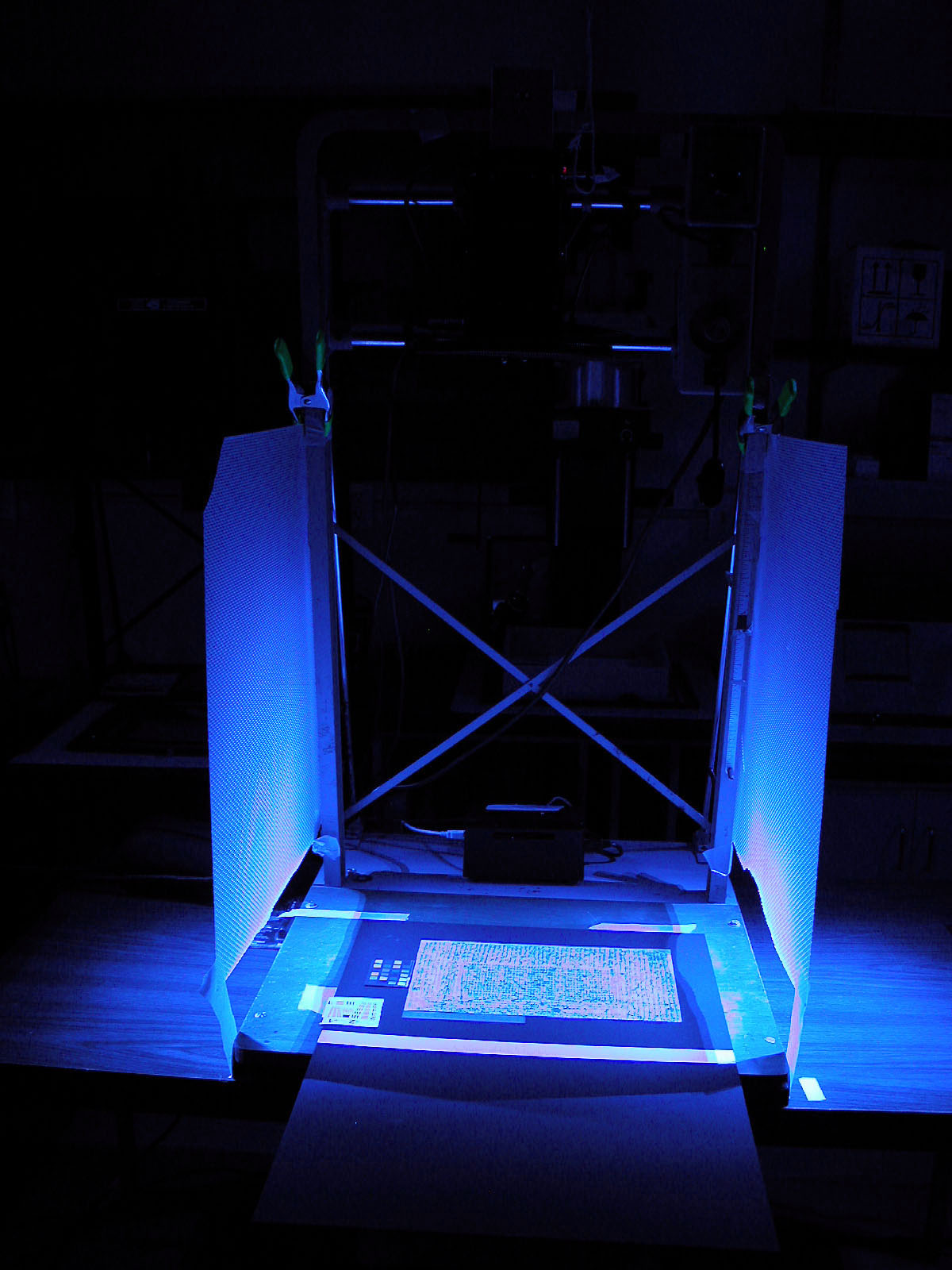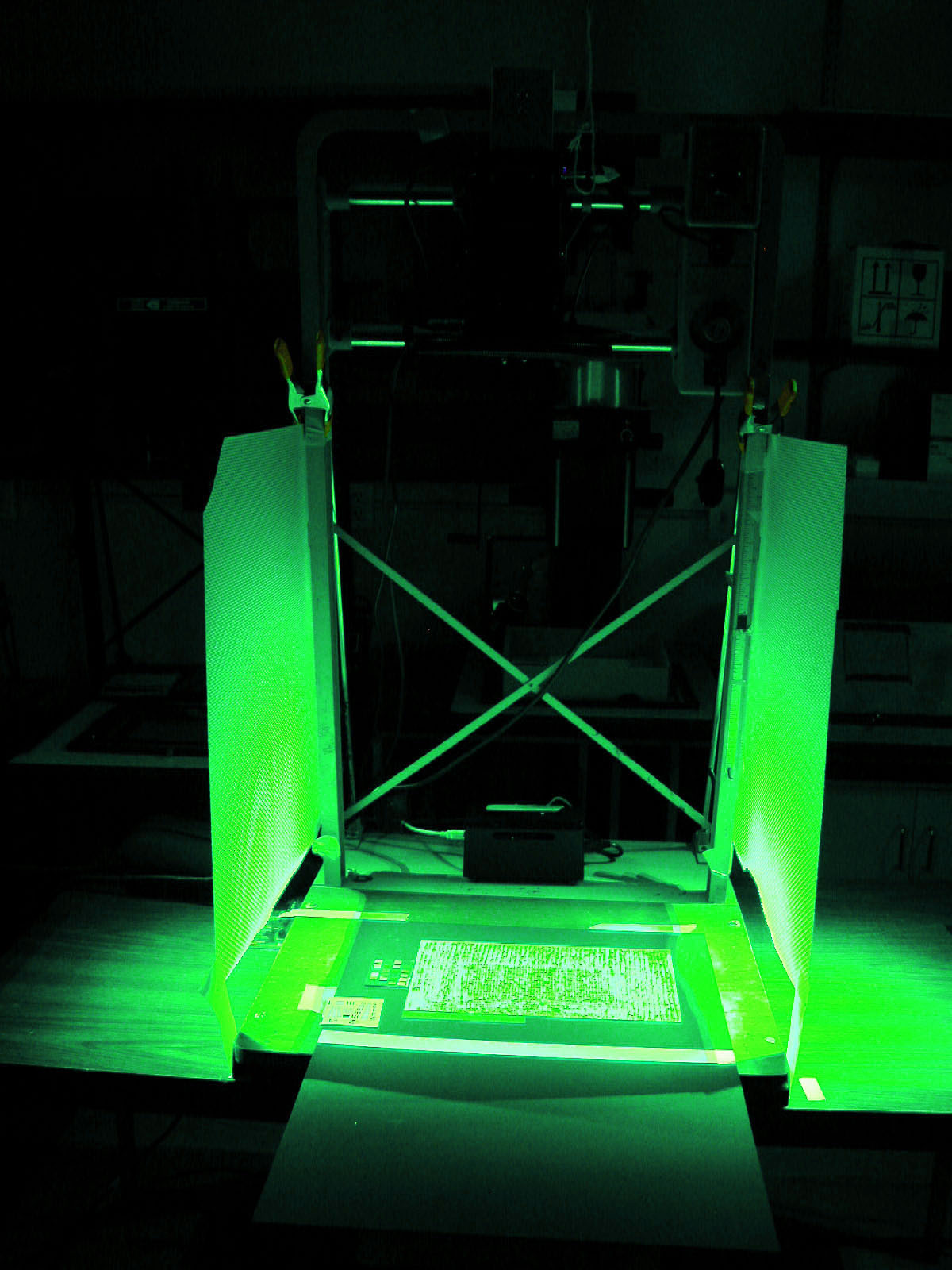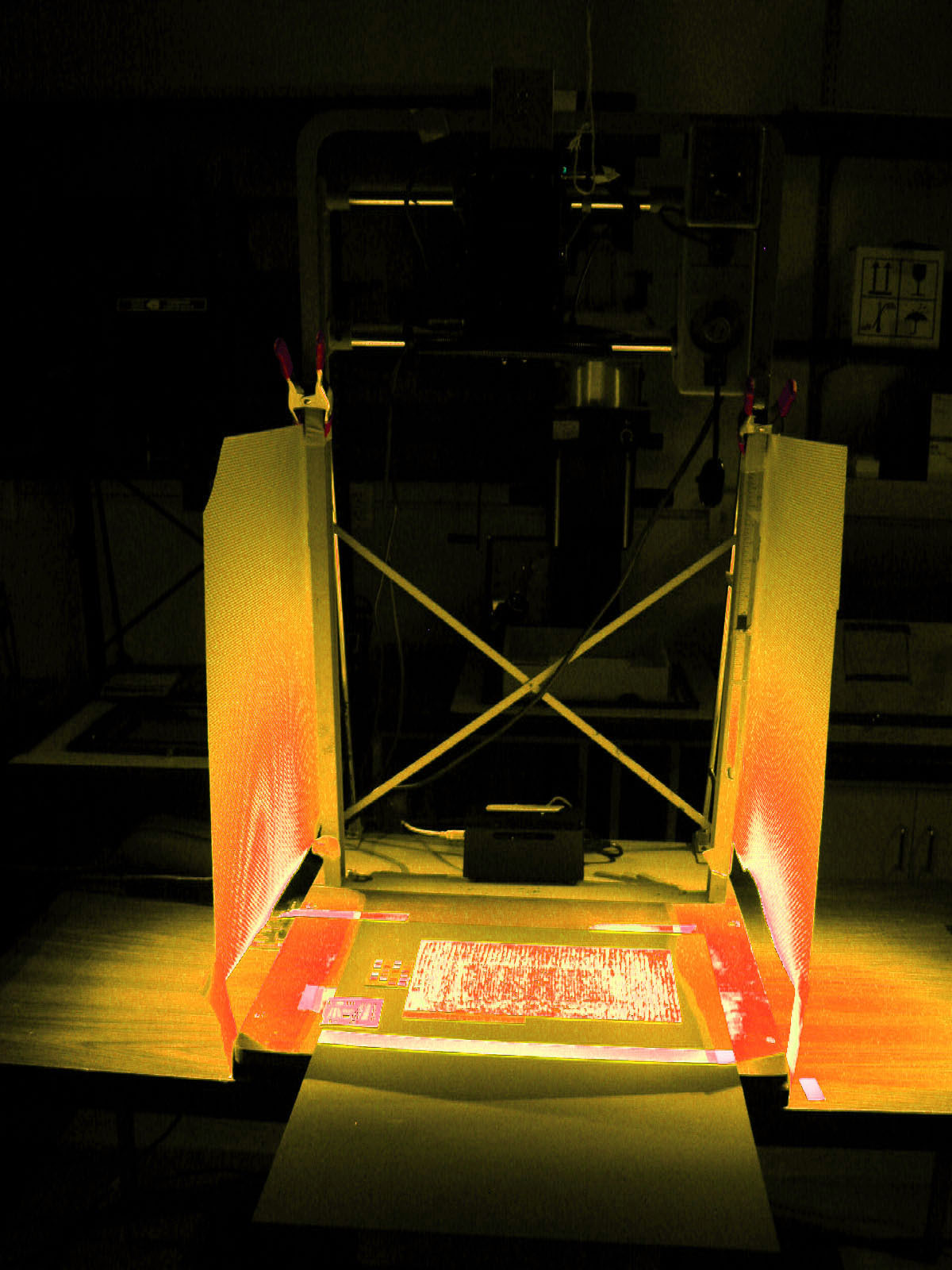Imaging the Letter
Cite page (MLA): Wisnicki, Adrian S., and Heather F. Ball. "Imaging the Letter." In Livingstone's Letter from Bambarre. Adrian S. Wisnicki, dir. Livingstone Online. Adrian S. Wisnicki and Megan Ward, dirs. University of Maryland Libraries, 2017. Web. http://livingstoneonline.org/uuid/node/d766c0a2-d67a-467f-b4a1-422cd48779e9.
This section opens by outling some of the legibility challenges posed by Livingstone's Letter from Bambarre. The section then discusses the spectral imaging opportunities offered by these challenges, describes the system used to carry out the spectral imaging, and provides key technical details related to the imaging.
In writing his letter to Waller, Livingstone used two pages from a proof copy of the Proceedings of the Royal Geographical Society (see Note on the Text of the Letter). He first wrote across the back of each sheet ([1] and [3]), then across the side with the printed text ([2] and [4]). In covering this latter side, he began by filling the top, left, and bottom margins, then turned the sheet ninety degrees clockwise and wrote in the remaining margin. Finally, without again turning the sheet, he wrote across the printed text, so that his "overtext" ran perpendicular to the print.
| (Left; top in mobile) A color image of a page of the Letter from Bambarre (Livingstone 1871c:[1]), detail. Copyright Peter and Nejma Beard. Creative Commons Attribution-NonCommercial 3.0 Unported. (Right; bottom) A color image of a page of the Letter from Bambarre (Livingstone 1871c:[4]), detail. Copyright Peter and Nejma Beard. Creative Commons Attribution-NonCommercial 3.0 Unported. The page at left shows bleedthrough from the other side of the page; the page at right shows Livingstone’s overtext, the printed undertext of the Proceedings, and bleedthrough from the other side of the page. |
Due to the paper used and Livingstone’s overtext, the letter to Waller is today very difficult to read. Where Livingstone’s iron gall ink has bled through the page, two layers of text run into one another, while on the portions of the page with printed text (or with the handwritten address to Livingstone), three superimposed layers of text are often visible.
Although problematic for the Livingstone scholar, these characteristics – in addition to the fact that the letter contains three types of ink (Livingstone’s, that of the printed text, and that of the handwritten address to Livingstone) – made the letter of great interest to the imaging team. The team recognized that the letter offered the chance to use the multispectral imaging and processing techniques developed to separate the "overtext" and "undertext" in the Archimedes Palimpsest, a medieval parchment-based document, for the study of a nineteenth-century paper-based document. Furthermore, the letter’s physical characteristics – such as the stains (most evident on [1] and [2]), the seal (on [4]), and the creases on each page where the letter had been folded – also presented an opportunity for innovative imaging and processing.
| (Left; top in mobile) Project director Adrian S. Wisnicki examines the letter and capture station just before imaging begins. Copyright Adrian S. Wisnicki. Creative Commons Attribution-NonCommercial 3.0 Unported. (Right; bottom) Imaging specialist Janet Safford (left), imaging scientist Bill Christens-Barry (at computer), and program manager Mike Toth (foreground) review the captured images. Copyright Adrian S. Wisnicki. Creative Commons Attribution-NonCommercial 3.0 Unported. |
The letter was transported from the Conservation Department at the Metropolitan Museum of Art in New York to the imaging lab at the Walters Art Museum in Baltimore, Maryland by a three-person team. At the Walters, in order to spectrally image the letter, the imaging team used a fully integrated spectral imaging system that included a 39-megapixel Megavision monochrome camera along with a low-heat spectral illumination system from Equipoise Imaging. This system illuminated each leaf with light-emitting diodes (LED) in various spectral bands, with each spectral band captured by the camera in a series of registered monochrome images so that a given point on every image lined up.
Although the Archimedes Palimpsest Project captured images at thirteen different wavelengths, for the Livingstone letter the imaging team increased this number to twenty-three. The team also used an experimental "color wheel" with filters to capture UV fluorescence from the manuscript leaves for later processing. All of the raw images were taken sequentially without moving the paper in between exposures. As a result, every image is in perfect registration with every other, allowing several images to be combined so as to enhance different parts of the document. The images, which totaled 13 GB as raw images, were stored as smaller archival TIFFs on external drives and distributed to members of the team for processing and further study.
| The Letter from Bambarre as illuminated by the following wavelengths: blue (430 nm), green (535 nm), orange (615 nm), and red (630 nm). Copyright Adrian S. Wisnicki. Creative Commons Attribution-NonCommercial 3.0 Unported. |
The wavelengths, or colors, of the raw images included one ultraviolet, two blue, three green, two red, and five infrared wavelengths. In addition, four images were taken with raking light, i.e., light shining on the surface of the paper at such a low grazing angle that the variations in the surface are emphasized. These four images were taken from the left and right sides of the paper, in both blue and infrared light. The captured images include the following spectra and illuminations:
Band = Wavelength in nanometers
01 = 365 (UV)
02 = 450
03 = 470
04 = 505
05 = 535
06 = 570
07 = 615
08 = 630
09 = 700 (near IR)
10 = 735 (near IR)
11 = 780 (near IR)
12 = 870 (near IR)
13 = 940 (near IR)
14 = 940RR (IR raking right)
15 = 470RR (blue raking right)
16 = 940RL (IR raking left)
17 = 470RL (blue raking left)
18 = UVR (UV illumination, red filter)
19 = UVG (UV illumination, green filter)
20 = UVB (UV illumination, blue filter)
21 = 450R (blue illumination, red filter)
22 = 450G (blue illumination, green filter)
23 = 450B (blue illumination, blue filter)



![Processed spectral image of a page from Livingstone's 1871 Field Diary (Livingstone 1871k:[5] pseudo_v1), detail. Copyright David Livingstone Centre and Dr. Neil Imray Livingstone Wilson: CC BY-NC 3.0 Processed spectral image of a page from Livingstone's 1871 Field Diary (Livingstone 1871k:[5] pseudo_v1), detail. Copyright David Livingstone Centre and Dr. Neil Imray Livingstone Wilson: CC BY-NC 3.0](https://livingstoneonline.org:443/sites/default/files/section_page/carousel_images/liv_013723_0001-new-carousel_0.jpg)



![Processed spectral image of a page from David Livingstone's "Retrospect to be Inserted in the Journal" (Livingstone 1870a:[3] pseudo_v4_BY), detail. Copyright National Library of Scotland and Dr. Neil Imray Livingstone Wilson: CC BY-NC 3.0 Processed spectral image of a page from David Livingstone's "Retrospect to be Inserted in the Journal" (Livingstone 1870a:[3] pseudo_v4_BY), detail. Copyright National Library of Scotland and Dr. Neil Imray Livingstone Wilson: CC BY-NC 3.0](https://livingstoneonline.org:443/sites/default/files/section_page/carousel_images/liv_000211_0003_pseudoBY_940_by_592-carousel.jpg)

![David Livingstone, Map of Central African Lakes, [1869], detail. Copyright National Library of Scotland: CC BY-NC-SA 2.5 SCOTLAND and Dr. Neil Imray Livingstone Wilson: CC BY-NC 3.0 David Livingstone, Map of Central African Lakes, [1869], detail. Copyright National Library of Scotland: CC BY-NC-SA 2.5 SCOTLAND and Dr. Neil Imray Livingstone Wilson: CC BY-NC 3.0](https://livingstoneonline.org:443/sites/default/files/section_page/carousel_images/liv_003006_0001-new-carousel_0.jpg)
![A color image of a page of the Letter from Bambarre (Livingstone 1871c:[1]), detail, that shows bleedthrough from the other side of the page. Copyright Peter and Nejma Beard. Creative Commons Attribution-NonCommercial 3.0 Unported (https://creativecommons.org/licenses/by-nc/3.0/). A color image of a page of the Letter from Bambarre (Livingstone 1871c:[1]), detail, that shows bleedthrough from the other side of the page. Copyright Peter and Nejma Beard. Creative Commons Attribution-NonCommercial 3.0 Unported (https://creativecommons.org/licenses/by-nc/3.0/).](/sites/default/files/spectral-imaging/imaging-the-letter/liv_002564_0001_color-article1.jpg)
![A color image of a page of the Letter from Bambarre (Livingstone 1871c:[4]), detail, that shows Livingstone’s overtext, the printed undertext of the Proceedings, and bleedthrough from the other side of the page. Copyright Peter and Nejma Beard. Creative Commons Attribution-NonCommercial 3.0 Unported (https://creativecommons.org/licenses/by-nc/3.0/). A color image of a page of the Letter from Bambarre (Livingstone 1871c:[4]), detail, that shows Livingstone’s overtext, the printed undertext of the Proceedings, and bleedthrough from the other side of the page. Copyright Peter and Nejma Beard. Creative Commons Attribution-NonCommercial 3.0 Unported (https://creativecommons.org/licenses/by-nc/3.0/).](/sites/default/files/spectral-imaging/imaging-the-letter/liv_002564_0004_color-article4.jpg)
